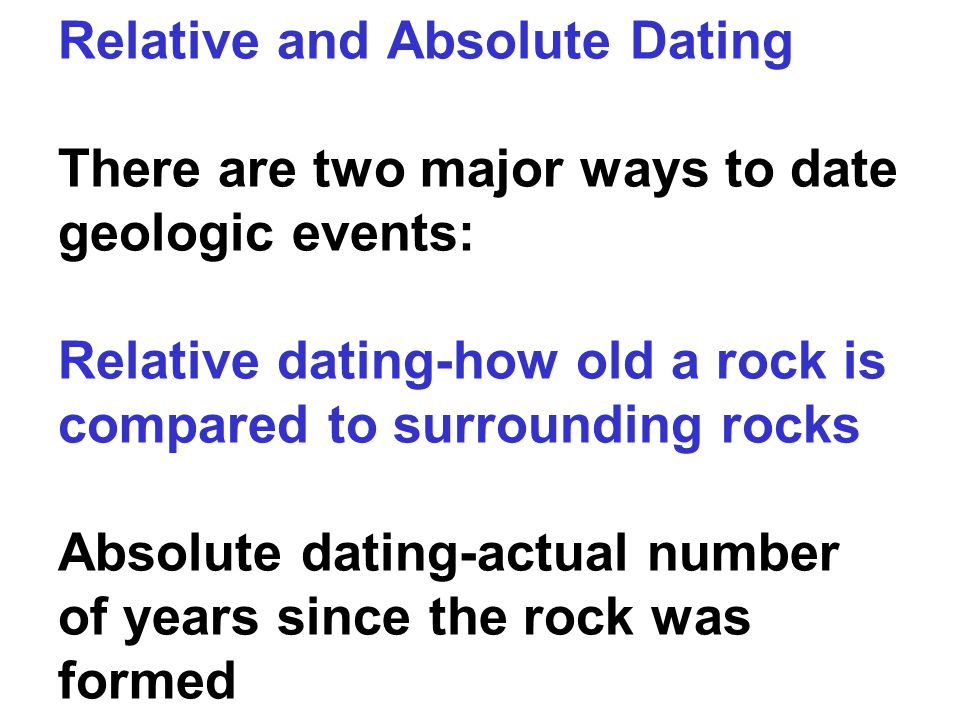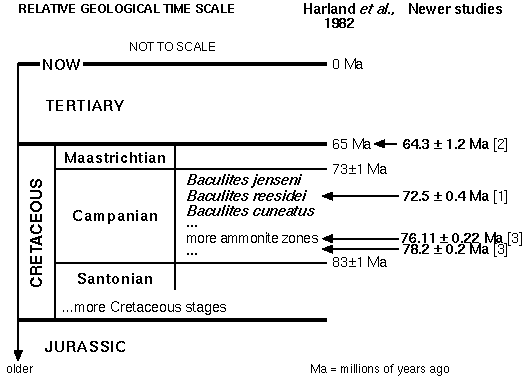- Relative Vs. Absolute Dating: The Ultimate Face-off
- Relative Dating vs. Absolute Dating: What's the Difference?
- Dating Techniques
- Historical Geology/Absolute dating: an overview
The comparison helps establish the relative age of these remains. Bones from fossils absorb fluorine from the groundwater. The amount of fluorine absorbed indicates how long the fossil has been buried in the sediments. This technique solely depends on the traces of radioactive isotopes found in fossils. The rate of decay of these elements helps determine their age, and in turn the age of the rocks. Physical structure of living beings depends on the protein content in their bodies. The changes in this content help determine the relative age of these fossils. Each tree has growth rings in its trunk.
This technique dates the time period during which these rings were formed. It determines the period during which certain object was last subjected to heat. It is based on the concept that heated objects absorb light, and emit electrons. The emissions are measured to compute the age. Differentiation Using a Venn Diagram. A Venn diagram depicts both dating methods as two individual sets. The area of intersection of both sets depicts the functions common to both. Take a look at the diagram to understand their common functions.
When we observe the intersection in this diagram depicting these two dating techniques, we can conclude that they both have two things in common: Provide an idea of the sequence in which events have occurred. Determine the age of fossils, rocks, or ancient monuments. Although absolute dating methods determine the accurate age compared to the relative methods, both are good in their own ways. Relative Dating Techniques Explained.
- nurse dating patient.
- university of minnesota alumni speed dating.
- Absolute dating;
- Navigation menu.
- Dating methods.
- Dating Methods;
How are Waterfalls Formed. Types of Metamorphic Rocks. How are Rivers Formed? What Tools do Archaeologists Use. Without radioactive dating , a clever forgery might be indistinguishable from a real artifact. There are some limitations, however, to the use of this technique. Samples that were heated or irradiated at some time may yield by radioactive dating an age less than the true age of the object.
Because of this limitation, other dating techniques are often used along with radioactive dating to ensure accuracy. Uranium series dating techniques rely on the fact that radioactive uranium and thorium isotopes decay into a series of unstable, radioactive "daughter" isotopes; this process continues until a stable non-radioactive lead isotope is formed. The daughters have relatively short half-lives ranging from a few hundred thousand years down to only a few years.
The "parent" isotopes have half-lives of several billion years. This provides a dating range for the different uranium series of a few thousand years to , years. Uranium series have been used to date uranium-rich rocks, deep-sea sediments, shells, bones, and teeth, and to calculate the ages of ancient lakebeds.
The two types of uranium series dating techniques are daughter deficiency methods and daughter excess methods. In daughter deficiency situations, the parent radioisotope is initially deposited by itself, without its daughter the isotope into which it decays present. Through time, the parent decays to the daughter until the two are in equilibrium equal amounts of each. The age of the deposit may be determined by measuring how much of the daughter has formed, providing that neither isotope has entered or exited the deposit after its initial formation.
Living mollusks and corals will only take up dissolved compounds such as isotopes of uranium, so they will contain no protactinium, which is insoluble. Protactinium begins to accumulate via the decay of U after the organism dies. Scientists can determine the age of the sample by measuring how much Pa is present and calculating how long it would have taken that amount to form. In the case of daughter excess, a larger amount of the daughter is initially deposited than the parent.

Non-uranium daughters such as protactinium and thorium are insoluble, and precipitate out on the bottoms of bodies of water, forming daughter excesses in these sediments. Over time, the excess daughter disappears as it is converted back into the parent, and by measuring the extent to which this has occurred, scientists can date the sample. If the radioactive daughter is an isotope of uranium, it will dissolve in water, but to a different extent than the parent; the two are said to have different solubilities. For example, U dissolves more readily in water than its parent, U, so lakes and oceans contain an excess of this daughter isotope.
Some volcanic minerals and glasses, such as obsidian , contain uranium U.
Relative Vs. Absolute Dating: The Ultimate Face-off
Over time, these substances become "scratched. When an atom of U splits, two "daughter" atoms rocket away from each other, leaving in their wake tracks in the material in which they are embedded. The rate at which this process occurs is proportional to the decay rate of U. The decay rate is measured in terms of the half-life of the element, or the time it takes for half of the element to split into its daughter atoms.
Relative Dating vs. Absolute Dating: What's the Difference?
The half-life of U is 4. When the mineral or glass is heated, the tracks are erased in much the same way cut marks fade away from hard candy that is heated. This process sets the fission track clock to zero, and the number of tracks that then form are a measure of the amount of time that has passed since the heating event. Scientists are able to count the tracks in the sample with the aid of a powerful microscope. The sample must contain enough U to create enough tracks to be counted, but not contain too much of the isotope, or there will be a jumble of tracks that cannot be distinguished for counting.
One of the advantages of fission track dating is that it has an enormous dating range. Objects heated only a few decades ago may be dated if they contain relatively high levels of U; conversely, some meteorites have been dated to over a billion years old with this method. Although certain dating techniques are accurate only within certain age ranges, whenever possible, scientists attempt to use multiple methods to date specimens. Correlation of dates via different dating methods provides a highest degree of confidence in dating. See also Evolution, evidence of; Fossil record; Fossils and fossilization; Geologic time; Historical geology.
Cite this article Pick a style below, and copy the text for your bibliography. Retrieved January 17, from Encyclopedia. Then, copy and paste the text into your bibliography or works cited list. Because each style has its own formatting nuances that evolve over time and not all information is available for every reference entry or article, Encyclopedia.
Movies and television have presented a romantic vision of archaeology as adventure in far-away and exotic locations. A more realistic picture might show researchers digging in smelly mud for hours under the hot sun while battling relentless mosquitoes. This type of archaeological research produces hundreds of small plastic bags containing pottery shards, animal bones, bits of worked stone, and other fragments. These findings must be classified, which requires more hours of tedious work in a stuffy tent.
At its best, archaeology involves a studious examination of the past with the goal of learning important information about the culture and customs of ancient or not so ancient peoples. Much archaeology in the early twenty-first century investigates the recent past, a sub-branch called "historical archaeology. Archaeology is the study of the material remains of past human cultures. It is distinguished from other forms of inquiry by its method of study, excavation. Most archaeologists call this "digging.
- romantic ideas while dating;
- supernatural dating profiles.
- free africa dating sites!
- dating sociopath quiz.
- dating silver spoons.
- free black dating sites;
- randy orton and jo jo offerman dating.
That sort of unscientific digging destroys the archaeological information. Archaeological excavation requires the removal of material layer by layer to expose artifacts in place. The removed material is carefully sifted to find small artifacts , tiny animal bones, and other remains.
Dating Techniques
Archaeologists even examine the soil in various layers for microscopic material, such as pollen. Excavations, in combination with surveys, may yield maps of a ruin or collections of artifacts. Time is important to archaeologists. There is rarely enough time to complete the work, but of even greater interest is the time that has passed since the artifact was created.
An important part of archaeology is the examination of how cultures change over time. It is therefore essential that the archaeologist is able to establish the age of the artifacts or other material remains and arrange them in a chronological sequence. The archaeologist must be able to distinguish between objects that were made at the same time and objects that were made at different times.
When objects that were made at different times are excavated, the archaeologist must be able to arrange them in a sequence from the oldest to the most recent.
Historical Geology/Absolute dating: an overview
Before scientific dating techniques such as dendrochronology and radiocarbon dating were introduced to archaeology, the discipline was dominated by extensive discussions of the chronological sequence of events. Most of those questions have now been settled and archaeologists have moved on to other issues. Scientific dating techniques have had a huge impact on archaeology.
Archaeologists use many different techniques to determine the age of an object. Usually, several different techniques are applied to the same object.
